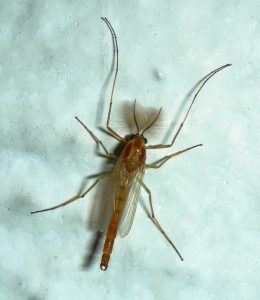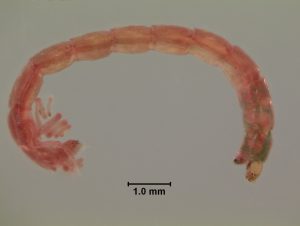- Ponds and streams provide aesthetic and environmental benefits. They also provide breeding habitats for swarms of flying pests like midges.
- These mosquito-like pests often draw concern and confusion among crowds encountering them about what they are and what they do.
- UF/IFAS experts at the Fort Lauderdale Research and Education Center want to clear the air of misconceptions on midges and how to manage them as they swarm into your space.
Humans derive many benefits from ponds, streams, lakes and rivers, including aesthetics, recreation, stormwater management, and places for wildlife to live.

Florida’s spring weather conditions are stimulating the emergence of swarms of insects including midges, which resemble mosquitoes. They are common in Florida, and they can make living along waterways a drag, said William Kern, an associate professor in entomology and nematology at UF/IFAS Fort Lauderdale Research and Education Center.
“For managers of apartments, businesses and homeowner communities, midges are a nuisance and can present a problem as complaints rise resulting from dissatisfaction to the employed management practices,” he said.
Kern authored ‘Some Small Native Freshwater Fish Recommended for Mosquitoes and Midge Control in Ornamental Ponds.’ In the publication, he provides more information on limited ways to control when the time is right. For added measure, Kern offers the following bites of scientific insight on what they are and what to expect when they invade your space.
Q: Midges are often confused for mosquitoes. What are they, and what makes them different?
A: Chironomid midges, also sometimes referred to as blind mosquitoes, are the size and shape of

medium to large mosquitoes. Their larvae are produced in huge numbers in the muck on the bottom of lakes, ponds and sluggish rivers. When the adults emerge in huge numbers, they can be very problematic. Both chironomid midges and mosquitoes are in the same suborder of primitive flies. They both go through aquatic larval stages, but because midge larvae are in the organic muck at the bottom of the lake, this makes them very hard to control. Adult chironomid midges do not bite or transmit disease. They live about two to three days.
Q: Are midges considered invasive pests?
A: Chironomid midges are not considered invasive as they are a native species that has thrived in human-modified habitats. These modifications to habitats include the use of fertilizers, or septic tank sewage leakage that cause excess algal and aquatic plant production. When this material dies and sinks to the bottom, it creates an organic ooze that has very little dissolved oxygen. This is the perfect habitat for midge larvae.
Q: Are midges dangerous to humans or pets?
A: They have been known to occur in such large numbers that their bodies have caused sidewalks and roads to become slick and cause falls or vehicle accidents. Some people with arthropod allergies may suffer mild allergic reactions like red itchy eyes and runny nose due to the large number of scales and hairs shed by the thousands of midges that emerge during a massive hatch.

sometimes as bloodworms because of the bright red color. Photo courtesy of Lyle J. Buss.
Q: Where and when are midges most likely to be found?
A: Near any large non-flowing or very slowly flowing bodies of water. The more organic matter on the bottom, the more midges will be produced. They occur statewide and different species swarm at different times of the year. Swarms are more common during the warm seasons, but that depends on the water conditions. I have watched midges emerging from sewage lagoons in January in north Florida due to warm waters from a power plant. In the subtropical Florida peninsula, a progression of species can emerge year-round.
Q: Can midges be controlled as a pest?
A: It is very difficult due to their life history. Midge larvae are unusual because they have hemoglobin to secure oxygen in environments with very low dissolved oxygen levels. Few predators can live in these habitats, so midge larvae have few predators and few competitors. It is also difficult for insecticide treatments to penetrate the muck layers where they are produced.
Q: Your article describes small native fish species that can be used to control midge populations. Is there an optimal time to incorporate them into the water?
A: Small native predatory fish like the Eastern mosquitofish and Least killifish reproduce quickly to reach the carrying capacity of the lake, pond, stream or canal. They are only able to feed on the pupae and emerging adults because the larvae are protected in the muck. If the muck is disturbed, then the larvae are vulnerable to predation. This is the concept of bottom aeration systems, but these systems also resuspend sediments containing nutrients sequestered in the muck that can cause algal blooms. You can stock the fish any time of the year depending on availability.
Q: Are there additional methods that people can use, other than predatory fish?
A: Lake drawdowns can mimic hundred-year droughts. The exposed muck oxidizes and dries down. In the past, during these natural droughts, fires from lightning would burn into the dry muck and burn it to ash, rejuvenating the lake bottom. Other lakes would gradually fill in to become marshes and transition into wet prairies, either of which are not good midge habitats.
Drawing down the lake to expose the bottom to drying conditions is the only economical method. Dredging to remove the muck by suction is generally not economically feasible but is another theoretical method.
-30-
By: Lourdes Mederos, 954-577-6363 (O); rodriguezl@ufl.edu
The mission of the University of Florida Institute of Food and Agricultural Sciences (UF/IFAS) is to develop knowledge relevant to agricultural, human, and natural resources and to make that knowledge available to sustain and enhance the quality of human life. With more than a dozen research facilities, 67 county Extension offices, and award-winning students and faculty in the UF College of Agricultural and Life Sciences, UF/IFAS brings science-based solutions to the state’s agricultural and natural resources industries, and all Florida residents.
ifas.ufl.edu | @UF_IFAS
 0
0
